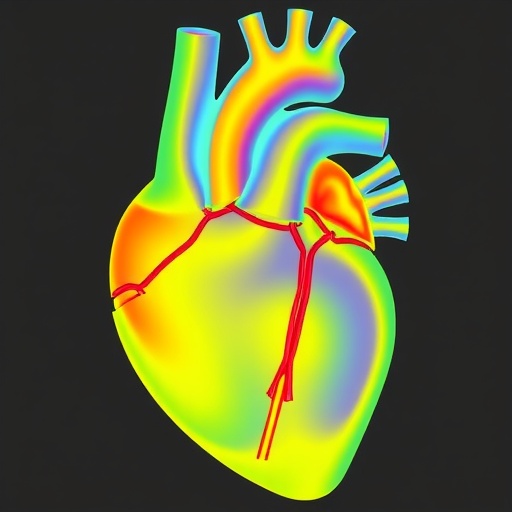Recent advancements in biomedical engineering and computational modeling have paved new avenues for understanding atrial arrhythmias, a prevalent heart condition affecting millions globally. Researchers, including Barrios-Álvarez de Arcaya, Termenón-Rivas, and Romitti, have made significant strides in analyzing how anatomical definitions and substrate conditions play crucial roles in the simulations that predict these cardiac events. Their work, anticipated to appear in the Annals of Biomedical Engineering in 2025, details a sophisticated study focusing on the intricate interplay between heart anatomy and the conditions that can precipitate arrhythmias.
Atrial arrhythmias encompass a variety of irregular heartbeats originating in the atria, the upper chambers of the heart. These irregularities can lead to severe complications, including stroke and heart failure. The study’s authors emphasize the necessity for precision in anatomical modeling to yield accurate simulations of these conditions. By taking into account potential variations in human anatomy, their research aims to enhance predictive accuracy and therapeutic strategies in clinical settings.
One of the central tenets of their research is the impact of anatomical variations on simulations. Human hearts exhibit a multitude of shapes, sizes, and structural differences, all influenced by genetic and environmental factors. The authors argue that traditional modeling methods often overlook these intricacies, leading to generalized simulations that may not accurately represent any particular individual. Instead, their methodology incorporates personalized anatomical definitions to create more reliable models, which could dramatically alter the landscape of arrhythmia management.
The research employs cutting-edge imaging techniques to capture detailed cardiac structures, ensuring that the models reflect the geometric complexity of actual human hearts. For instance, magnetic resonance imaging (MRI) and computed tomography (CT) scans provide high-resolution images that serve as the foundation for the anatomical specifications used in simulations. The authors advocate for a multi-faceted approach, integrating imaging data with advanced computational algorithms to enhance simulation fidelity.
Moreover, the substrate condition—the electrical and structural environment surrounding cardiac cells—also plays a pivotal role in the manifestation of arrhythmias. The study underscores that heart tissue can change structurally over time due to various factors, including ischemic conditions or fibrosis. These alterations can significantly influence how electrical impulses propagate through the heart, potentially leading to arrhythmias. By factoring in these variables, the researchers aim to create simulations that account for both transient and chronic alterations in cardiac substrate.
The implications of this research extend beyond the laboratory. Accurate simulations can lead to improved therapeutic strategies such as targeted ablation, where specific areas of the heart are treated to circumvent arrhythmias. By leveraging detailed simulations, clinicians will be better equipped to identify at-risk patients and tailor interventions suited to individual anatomical and substrate conditions. This personalized approach could revolutionize patient care within cardiology.
Furthermore, the study acknowledges that while technological advances have greatly enhanced our understanding of atrial arrhythmias, challenges still persist. Researchers face hurdles in obtaining consistent and high-quality imaging data. Variability in imaging techniques and the subjective interpretation of results could introduce biases that compromise the accuracy of simulations. The authors stress the need for standardized protocols in obtaining and processing cardiac images to mitigate these issues.
In addition, ethical considerations regarding data ownership and patient privacy must be addressed as personalization in cardiac modeling becomes more prominent. The use of patient-specific data raises questions about consent and the potential for misuse of sensitive health information. The researchers emphasize the importance of developing robust ethical frameworks to guide the application of their findings in clinical practice.
As the investigation unfolds, the researchers consider real-world applicability paramount. They are exploring partnerships with clinical institutions to deploy their simulations in practice settings. This collaboration aims to validate their models against actual patient outcomes, ensuring that theoretical advancements translate into tangible benefits for patients suffering from atrial arrhythmias.
The overall significance of this research lies in its potential to bridge the gap between theoretical modeling and clinical practice. By addressing both anatomical intricacies and surrounding substrate conditions, Barrios-Álvarez de Arcaya and colleagues are not just simulating arrhythmias; they are paving the way for more effective, person-centered treatments that address the root causes of these conditions.
Such innovations also hold promise for educational purposes. By using realistic simulations as teaching tools, medical students and professionals can gain deeper insights into the complexities of heart rhythm disorders. The visual and interactive nature of these models could enhance understanding and retention, ultimately improving clinical skills in diagnosing and managing atrial arrhythmias.
In a landscape where heart diseases remain a leading cause of mortality worldwide, the study’s findings are poised to influence future research trajectories. As the quest for precision in medicine continues to gain momentum, this work serves as a vital reference point for cardiovascular researchers and healthcare professionals alike.
In conclusion, the intricate relationship between anatomical definitions and substrate conditions offers a rich field for exploration within atrial arrhythmia research. The findings from Barrios-Álvarez de Arcaya, Termenón-Rivas, and Romitti are likely to catalyze further studies, igniting a collaborative spirit among researchers determined to unravel the complexities of arrhythmias. Through ongoing innovation in modeling and simulation, the future of cardiac care may soon witness a paradigm shift toward more individualized patient interventions, ultimately enhancing outcomes for those impacted by these challenging conditions.
Subject of Research: Atrial Arrhythmias and their Simulation Based on Anatomical and Substrate Conditions
Article Title: Influence of Anatomical Definition and Substrate Condition on Simulations of Atrial Arrhythmias
Article References:
Barrios-Álvarez de Arcaya, J., Termenón-Rivas, M., Romitti, G.S. et al. Influence of Anatomical Definition and Substrate Condition on Simulations of Atrial Arrhythmias.
Ann Biomed Eng (2025). https://doi.org/10.1007/s10439-025-03856-2
Image Credits: AI Generated
DOI: https://doi.org/10.1007/s10439-025-03856-2
Keywords: Atrial Arrhythmias, Cardiac Modeling, Biomedical Engineering, Personalized Medicine, Anatomical Variation, Substrate Condition, Arrhythmia Management, Computational Simulation.




